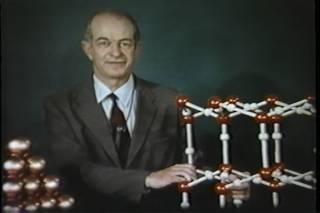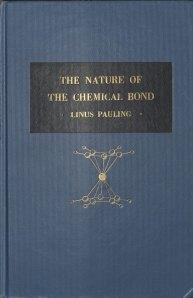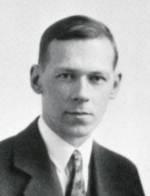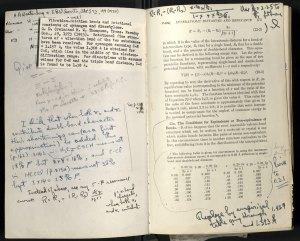
Pauling lecturing on valence and molecular structure, 1957.
[Celebrating the 75th anniversary of The Nature of the Chemical Bond. Part 6 of 6.]
Not all of the responses to The Nature of the Chemical Bond that Linus Pauling received were from academics; some came from students. Lois Joyce was one such respondent. Working her way through graduate school at the University of Illinois, she began contacting Pauling in May 1939 in hopes that she could study with him at Caltech. She told Pauling how she was much more interested in his focus on molecular structure than on the analytical chemistry that she was studying at Illinois. By July, after bringing her case before the Division of Chemistry and Chemical Engineering at Caltech, Pauling was compelled to tell Joyce that he could not bring her aboard due to Caltech’s restriction on women without Ph.Ds working in their labs. Pauling encouraged Joyce to continue on and get her doctorate at the University of Chicago, after which point she might be able to join him.
A month later, Pauling received a letter from Joyce’s mother asking for an autographed copy of what she could only remember as “The Strength of the Chemical Bond” for her daughter’s birthday. She told Pauling how Joyce thought Pauling to be “one of the greatest men in the world” and that even though “it’s a strange career for a girl” her daughter was “deeply interested in X-ray research and willing to give up all pleasure in life to succeed,” often studying “until two and three in the morning.” Pauling obliged by signing and sending a copy of his book through special delivery, as Joyce’s birthday was only days away. Joyce was overjoyed when she received the gift, telling Pauling that she was glad her mother “bothered” him to send a copy and that she was “never so thrilled.” Joyce still regretted that she was unable to work with Pauling however, telling him again that the only topic she wanted to study was molecular structure.

Scholarly reviews of The Nature of the Chemical Bond did not start appearing until 1940, the year following its publication. Many of the reviews offered soaring praise not only for the book, but for Pauling as well. They also included more technical criticism than had been contained in the letters that Pauling had received earlier from his colleagues.
The Transactions of the Faraday Society published a review, identifying the author as L. E. S., which played off the assumption that Pauling was already so well-known as to need little in the way of an introduction. L. E. S. noted, “All who have researched in the field of molecular structure have long awaited this book.” According to the review, Pauling’s account mostly focused on “the structure of individual molecules…with problems centering around relatively normal covalent bonds.” It also included a “delightful chapter” on the hydrogen bond and two “succinctly but excellently discussed” chapters on the structure of crystals.
Similar praise came from John E. Vance in the American Journal of Science and George B. Kistiakowsky in the Journal of the American Chemical Society, who both lauded Pauling’s non-mathematical style. Kistiakowsky added that Pauling’s presentation was “by and large…lucid, and a student with little more preparation than the four basic courses in chemistry should be able to digest most of the contents.” Indeed, even novices might be interested and find the text “stimulating.” The reviews from Germany echoed these sentiments, though one author in the Zeitschrift des Vereins Deutscher Chemiker was disappointed that Pauling, like most English chemists, ignored the German literature on the subject.
As the reviewers continued, they brought in a handful of criticisms of Pauling’s work. L. E. S. found that Pauling had oversimplified his discussion and gave it a “premature happy ending.” According to L. E. S., these flaws emerged from Pauling having written such a broad survey and resulted in assumptions along the lines of “the electric dipole moment of a purely covalent link is small or is zero,” a suggestion presented without any proof. L. E. S. wrote that Pauling’s certainty in his own understanding came “partly from this simplification and partly from tricks of style.”
Kistiakowsky made a similar observation, calling attention to Pauling’s “pontifical style” and “his advocacy of the doctrine of infallibility of Pasadenean research,” before concluding that this was “understandable and should not be taken amiss.”
A more serious criticism came from Vance, writing in December 1939, who complained that Pauling ignored a large stream of the chemical discourse then current, and in particular found it “remarkable that no mention of the Hund-Mulliken treatment of chemical bonds,” based on molecular orbitals, appeared in the text. Such an inclusion, Vance thought, surely would have increased the “usefulness of the book.” He was not the only person who felt this way.

Robert Mullikan, 1929.
In June 1940, Robert S. Mulliken – himself a rising scientific star and future Nobel Prize winner whose atomic structure work was sometimes at odds with Pauling’s theories – published his own review in the Journal of Physical Chemistry. Mulliken initially took a generous tone, calling Pauling’s book a “clearly written survey of the nature of the chemical bond,” before adding the critical clause, “from the viewpoint of the atomic orbital method.” This viewpoint, Mulliken ceded, was most suited to combining wave mechanics with the “traditional ideas” of chemical bonds and therefore had “wide appeal and usefulness among chemists,” but it was not the only perspective in play: Mulliken’s molecular orbital model, developed with Friedrich Hund, was a competing body of work that Pauling largely ignored.
Mulliken suggested that Pauling’s failure to include a molecular orbital perspective, except for a brief “aside,” was misleading, especially for the “unfamiliar reader.” “Most authorities,” according to Mulliken, “would feel that for a deeper understanding of the electronic structures of molecules a knowledge of both methods is necessary, and that for many problems the MO [molecular orbital] method is the simpler and more intelligible.” Despite this criticism, which became more common over the years, Mulliken ended on an upbeat note, echoing his earlier comment on the volume’s usefulness and recognizing that “the book is a landmark in the history of valence theory.”
While criticism, like Mulliken’s, urging Pauling to add another theoretical perspective to The Nature of the Chemical Bond may not have been exactly what Pauling was looking for from the public response to his book, he would not be able to incorporate any of this new feedback into the next edition anyway. After he had received his requested interleaved copy from W. S. Schaefer of Cornell University Press back in October 1939, Pauling quickly got to work on making revisions. By December he was already sending in the first three chapters to Schaefer and by May 1940 the second edition was out, published one year after the first edition and one month prior to Mulliken’s review, also of the first edition. The opportunity to incorporate new suggestions was not completely lost, however, as Pauling began working on yet another version of his landmark text just one year later, in 1941.

Pauling’s interleaved copy, full of notes for future revisions.
